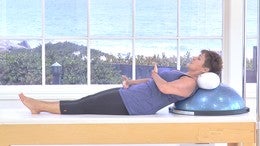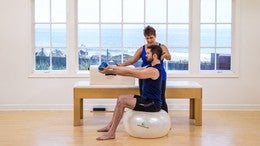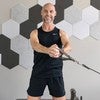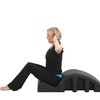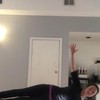Description
About This Video
Transcript
Read Full Transcript
I love this next tutorial. It's kind of an expansion on a couple of previous tutorials that I have done. One is called, where's your head? Uh, there's another one about the deep neck flexors. Uh, so in this one I really want you to become, to understand that the bridge of your nose, okay, if you follow the bridge of your nose back behind your eye socket, that's kinda like the middle of your occiput there. Okay? So the bridge of your nose, like where you'd push your glasses up again, middle of the eye socket, it's comes right there to that big Ridge. When it sucks out, it's not necessarily the full base, but it's right there at the center of it.
So we can play with our head position kind of like this or kind of like this. And oftentimes what happens is we have to learn the positioning of our head is a back position. It's not like a double chin position, it's not a tuck position, it's just a back position. Kind of like we've learned in tutorials about the position of the ribs. It's not always the abs that pull your ribs back. Sometimes it's just getting in that position. So this next exercise, I have a little squishy ball. I'm still going to be talking, but I'm going to be facing in the other direction.
So I'm going to put the ball against the wall and I'm going to put my forehead on it, kind of down to the bridge of my nose. So it's about like this. Okay. So can you kind of see that like that. But I'm gonna use the wall because it really makes sense and I'm going to do some stuff with my arms and my legs. So in this position here, a, I'm pressing ever so gently into the ball. Not a lot to get my entire external neck and gauge, but way back behind my throat almost is like where my deep neck flexors, uh, reside. So in this position here, I'm going to look forward into the ball and I'm going to move my arms up and down in different actions here so that I don't always have to arch my neck or flex my neck to do the action. One of my favorite ones is the arms come up and then the shoulder blades elevate and protract, and then they depress and retract.
So by pressing my head gently into the ball, but feeling the bridge of my nose connect with the back of my skull. It makes a really deep front line connection from the front of my neck to the front of my trunk. Now I'm going to take this same idea and I'm gonna move left leg out and in right leg out in it. I'm not going to be perfectly still, but I am going to be in pretty good alignment here with my back of my skull, over my thoracic area and the back of my ribs over my pelvis. Um, do this one more and then now I'm going to take my right leg and lifted a Whoa. That got me a little bit unbalanced to the hair and put it down.
And then I'm going to take my other leg and lifted up all while maintaining this position of my head into the ball. So again, in this shape here, you'll see that I'm not jutting my chin out extending my neck. I'm not flexing my neck. I'm just pressing forward as I pull that bridge of my nose right back here to the back of my occiput back and you can kind of almost see how that gets a nice deep front line here as well. We're going to transfer this exercise now onto the reformer.
It'll be face down and it'll allow me a nice exercise against gravity for my arms and my chest. Continuing on in the face down position, I want to make sure that the back of my neck is not sure like this, I'm not going to sag. It changes my voice. I'm okay almost pressing my forehead down. My eyes are open. They're looking straight down towards the floor so that the base of my skull is, is where the bridge of my nose is again, so I'm almost feeling like there's a magnet pulling me up to the ceiling, but forehead is gently pressing down, so just going to hold that shape right there. My arms are very long by my side and very strong.
As I stay here, I lift my arms up and down. I am doing this because I want to differentiate arms strength from shortening the back of my neck. Now what I can do is lift my arms. I can unweight my head, I can start to extend my chest, which is spinal extension. And then I can shorten the back of my neck, which is neck extension.
But then I have to know how to come out of it and come down my forehead on the [inaudible] bar, my arms down, and then I rest. I could even take my hands here down by the side and almost think engage thighs, push arms, pull belly. And there's my head alignment again. So as I hold this here, take my arms out to the side. Now I'm gonna do arms pull up, buttocks pulls up and down. So now I'm working posteriorly from my glutes, my back, and my upper back, but not my neck.
Sometimes those little short neck extensors want to come in too much. So I'm going to lift up, stay up. I can start to lift my chest, I can shorten the back of my neck, which will become rocking where the whole front body is long and the back body shortens. But I first had to understand how to create that connection right here. Now we'll progress on to this same connection in sideline.
So we're going to take, I'm going to put on an extra spring here and uh, turn this this way. And again, the spring is just for a little support there. So I'm gonna put my foot under here. Of course, do you know how to do the short box business, et cetera, et cetera. But what I want you to notice is a lot of people when they come in to short box, they really don't want to trust that leg. They really don't want to use their lateral line.
I'm not judging the person doing the exercise, I'm, I'm, I'm saying that the body sometimes wants to be driven by an extension for say, which would look like this. That'd be an extension force driven exercise. And a side of this would be a flection force, right? But what I want to create is this nice sideline connection. So that bridge of my nose, back of my occiput, front ribs, two back ribs, back ribs over the pelvis, et cetera, et cetera. So that now my alignment is, is one where I can hold this in this side position.
I have to first be able to hold it before I start to side bend it. So I don't really care how far I side bend, but I want to be managed with my head in line with my uh, spine and that the front of my face, of course, kind of pulling back, like I've explained before. So our Muff, other arm down holding, now I'm using this whole lateral line, lateral neck, and then I'm going to side bend up
Comments
You need to be a subscriber to post a comment.
Please Log In or Create an Account to start your free trial.
